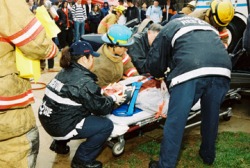Drowsy Driving

Data from the National Highway Transportation Safety Administration indicates that there are about 56,000 crashes annually in which driver drowsiness/fatigue was cited by police. Annual averages of roughly 40,000 nonfatal injuries and 1,550 fatalities result from these crashes. It is widely recognized that these statistics underreport the extent of these types of crashes. These statistics also do not deal with crashes caused by driver inattention, which is believed to be a larger problem.
Shift work may increase the risk of drowsy-driving crashes. Night, early morning, and rotating-shift workers are often sleepy because their work times are inconsistent with the natural sleep-wake cycle.Workers on these shifts routinely get less sleep and lower quality sleep than do day workers. Driving while sleepy is a risky behavior that leads to many serious crashes each year.
Driving between midnight and 6 a.m. and driving home immediately after an extended or night shift are special risks for a drowsy-driving crash. Driving during late night/early morning hours increases risk for all drivers because those hours are a natural period of sleepiness. Many drowsy-driving crashes occur at this time. Driving while acutely tired, such as after a night shift, also increases the risk of crashing. Shift workers, many of whom are already chronically sleep deprived, are at extra risk.
You can take effective steps to reduce your risks. First, it is important to give regular priority to getting good sleep by creating a quiet, cool, dark environment, allowing sufficient time for sleep, and trying to sleep during the same hours each day. Another strategy is to avoid driving home from work while sleepy (e.g., getting a ride from a family member, taking a cab, napping before heading home). Consuming caffeine equivalent to two cups of coffee may help improve alertness for a short period.
For additional information, see http://www.nhtsa.dot.gov/people/injury/drowsy_driving1/Drowsy.html
Shift work may increase the risk of drowsy-driving crashes. Night, early morning, and rotating-shift workers are often sleepy because their work times are inconsistent with the natural sleep-wake cycle.Workers on these shifts routinely get less sleep and lower quality sleep than do day workers. Driving while sleepy is a risky behavior that leads to many serious crashes each year.
Driving between midnight and 6 a.m. and driving home immediately after an extended or night shift are special risks for a drowsy-driving crash. Driving during late night/early morning hours increases risk for all drivers because those hours are a natural period of sleepiness. Many drowsy-driving crashes occur at this time. Driving while acutely tired, such as after a night shift, also increases the risk of crashing. Shift workers, many of whom are already chronically sleep deprived, are at extra risk.
You can take effective steps to reduce your risks. First, it is important to give regular priority to getting good sleep by creating a quiet, cool, dark environment, allowing sufficient time for sleep, and trying to sleep during the same hours each day. Another strategy is to avoid driving home from work while sleepy (e.g., getting a ride from a family member, taking a cab, napping before heading home). Consuming caffeine equivalent to two cups of coffee may help improve alertness for a short period.
For additional information, see http://www.nhtsa.dot.gov/people/injury/drowsy_driving1/Drowsy.html